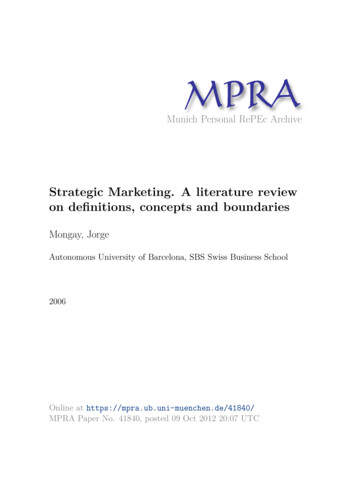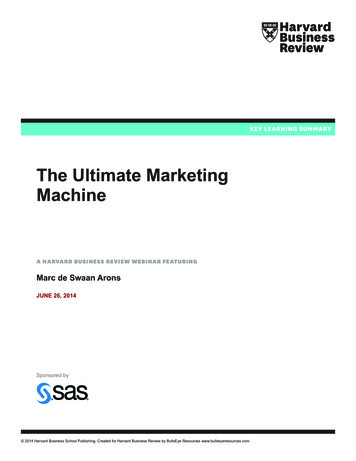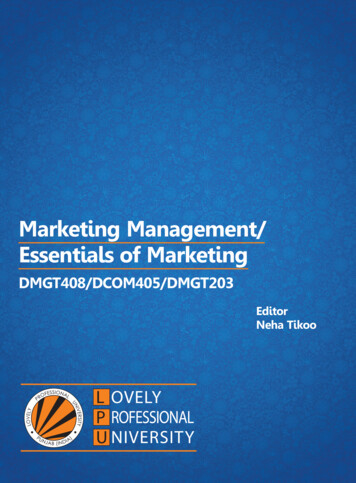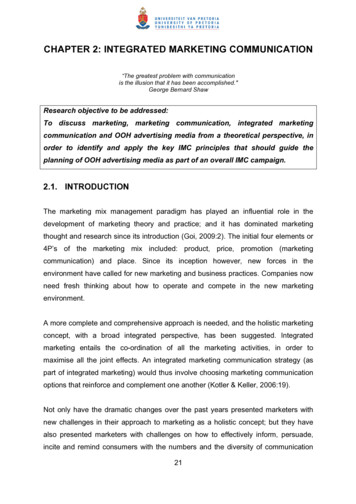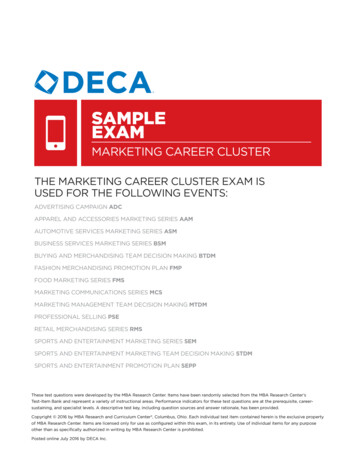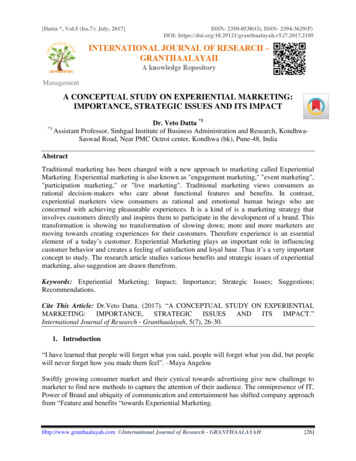
Transcription
MARKETINGSTRATEGY AND MANAGEMENT
Other books by MichaelJ. Baker includeDICTIONARY OF MARKETING AND ADVERTISINGMARKETING: AN INTRODUCTORY TEXTMARKETING: THEORY AND PRACTICERESEARCH FOR MARKETING
MARKETINGSTRATEGY ANDMANAGEMENTSecond EditionMichaelMJ.MACMILLANBaker
Michael J. Baker 1985, 1992All rights reserved. No reproduction, copy or transmissionof this publication may be made without written permission.No paragraph of this publication may be reproduced, copied ortransmitted save with written permission or in accordance withthe provisions of the Copyright, Designs and Patents Act 1988,or under the terms of any licence permitting limited copyingissued by the Copyright Licensing Agency, 90 Tottenham CourtRoad, London W1P 9HE.Any person who does any unauthorised act in relation tothis publication may be liable to criminal prosecution andcivil claims for damages.First edition 1985Reprinted 1988, 1989, 1990Second edition 1992Published byTHE MACMILLAN PRESS LTDHoundmills, Basingstoke, Hampshire RG21 2XSand LondonCompanies and representativesthroughout the worldISBN 978-0-333-57644-1ISBN 978-1-349-22167-7 (eBook)DOI 10.1007/978-1-349-22167-7A catalogue record for this bookis available from the British LibraryCopy-edited and typeset by Povey-EdmondsonOkehampton and Rochdale, England
To my family- Sheila, john, Fiona and Anne
I Conten tsList of FiguresXIVList of TablesxvuPreface to the Second EditionAcknowledgementsPART Ix1xxxuMARKETING STRATEGY11 Prologue3Introduction3The point of departure3The strategic perspective in marketingScope of the book842 Marketing and competition15Learning goals15Introduction16Competition17What is marketing?19Market structure, conduct and performanceCompetition and marketing strategy23International competition28The 'diamond of national advantage'29The role of government and chance33The development of 'clusters'34The creation of competitive advantage35Marketing and competitive success38Summary423 Marketing and corporate strategy44Learning goals44Introduction44The development of the marketing functionVll2145
vmContentsCorporate strategy47The concept of the firm's business52The concept of limited strategic alternatives57Corporate strategy or marketing strategy?60General management and marketing managementSummary66654 Principles of strategic marketing planning67Learning goals67Introduction67The evolution of management systems69Some definitions73Formulating objectives75A framework for strategic marketing planning78Principles of SMP83The formulation of corporate strategy87Criticisms of and obstacles to strategic planning89Summary965 Analytical frameworks for strategic marketing planningLearning goals98Introduction99The product life-cycle100Diffusion theory109Using the PLC as a planning tool114Product portfolio analysis116Business portfolio analysis under attack121Strategic overviews125Gap analysis130Scenario planning132SWOT136Summary1376 The marketing environment139Learning goals139Introduction139The environment as the ultimate constraintDemographic factors141Social and cultural factors145Political and governmental factors146Economic factors148Technological factors149Cycles and trends15214098
ContentsCompetition155Non-price competition157Changing times changing valuesWhat next?160Summary1621591637 Buyer behaviourLearning goals163Introduction163Choice and the social sciences164Selective perception169Hierarchy of needs173Hierarchy of effects174Post-purchase dissonance175Buy phases176Characteristics of goods177Buyer behaviour and the decision-makerThe Baker composite model179Using the model182Summary1871788 Market segmentation188Learning goals188Introduction188Product differentiation vs market segmentationBases for segmentation191Procedure and methods194Cluster analysis196Major segmentation methods199Location as a basis for segmentation200Demographic segmentation203Psychographic and behaviouristic segmentationUsage segmentation204Benefit segmentation207Segmenting industrial markets209When to segment210Summary2162189 PositioningLearning goals218Introduction218Perceptual mapping219Positioning in the mind2251892031x
xContentsBranding228Building a brand reputationSummary24023110 Situation analysis: the marketing auditLearning goals241Introduction241Marketing audits242Competitor analysis250Sales forecasting253Summary25924111 The marketing mix260Learning goals260Introduction260The evolution of the marketing mix concept261Identifying the ingredients of the marketing mix262Selecting the right mix266Managing the mix271Summary275PART II MANAGING THE MARKET FUNCTION12 Marketing research279Learning goals279Introduction279The need for marketing research280Quantitative or qualitative research?284Data collection287Secondary sources of data287The collection of primary data289Probability samples290Non-probability samples292Field survey methods292Market assessment, research checklist295Data reduction and analysis296Bayesian analysis299Developing a decision tree304Analysing the decision tree309Summary310277
Contents13 Product policy313Learning goals313Introduction313The role of the product in marketing314User needs and product characteristics316Product classification and marketing strategy319Some definitions of the 'product'321Product policy322Product development328The new product development (NPD) cycle329Organisation for new product development333Managing the product life-cycle335Monitoring product performance344Summary34714 Packaging348Learning goals348Introduction348Definitions349Packaging criteria349Developing the pack354Summary35915 Pricing policy and management360Learning goals360Introduction360Theoretical foundations361Limitations and contributions of price theory365Pricing objectives367Profit objectives369Sales-oriented objectives371Pricing objectives in practice373Price determination374Cost-plus pricing375The contribution approach376The role of pricing in the marketing mix377Pricing strategies382Summary38316 Distribution and sales policy385Learning goals385Introduction385Why do channels develop?387XI
xuContentsFunctions of a channel389Channel composition391Factors influencing channel structure391Selecting the distribution channel394Formulating a distribution policy399Vertical marketing systems401Personal selling403Sales and distribution effort through the product life-cycleSummary40617 Promotion policy and management408Learning goals408Introduction408The nature of the communication processHow does advertising work?412Promotion objectives415Developing a promotional strategy421Setting the advertising budget423Measuring advertising effectiveness430Summary433PART III IMPLEMENTING MARKETING41043518 Service437Learning goals437Introduction437The nature of customer service438The scope of customer service440The strategic use of customer service447Total Quality Management (TQM)450Pricing services452Measuring service quality453Service as a marketing strategy454Summary45619 Developing a marketing culture458Learning goals458Introduction458Organising for marketing461Basic business orientations461Developing a market-orientated organisationMission, vision and strategic intent470468404
Contents473The mission statement475Implementing marketing479Summary48020 The (short-term) marketing plan480Learning goals480Introduction481A framework for marketing planningEssential components of the short-term marketing plan490Summary49121 Control491Learning goals491Introduction492Profits and performance494Cost analysis498Other important cost concepts500Contribution analysis505Cash flow and net present value507Management ratiosSummary: the importance of control in marketing22 Recapitulation515515IntroductionThe 'virtuous circle' of best marketing practice518Marketing and competitive success523Maxims for marketers528A Baker's dozen of key conceptsNotes and referencesIndex553533513516484xm
I List of .16.26.37.18.1The structure-conduct-performance paradigm22Forces governing competition in an industry25Determinants of national competitive advantage30Factors influencing competitive success41Taxonomy of strategic decision-making53Growth vector components57The 'attack' problem58The product life-cycle61Generic strategies64Characteristics of effective strategy statements81The marketing planning process82The cycle of SMP83The strategic condition matrix86A depiction of the strategy centres concept88Phases in the development of strategic planning91Four introductory marketing strategies102Classic fashion good PLC105Innovation of new products postpones the time of total maturity- nylonindustry107Distribution of adopters over time110Cumulative adoptions over time110The business portfolio and associated cash flow120Product portfolio sector: strategic guidelines122The stages of planning124The directional policy matrix1253 x 3 chart depicting relative investment opportunity127General Electric's 'stoplight strategy'130The directional policy matrix131Ansoff's gap analysis chart132Gap analysis133UK actual and projected total population, 1945-2010143Significant technological events within a single lifetime150The phases of an economic cycle153Features of a machine tool considered one of the three mostimportant181Alternative perspectives of the total market190XlV
List of erceptual map195Annual purchase concentration in 18 product categories206Map of the six benefit segments214Hypothetical model of a retail market223Hypothetical model of a retail market, including the position of the 'ideal'store223Hypothetical model of a retail market, including the 'ideal' store andconcepts224The relationship between market share and profitability230What is a brand?232Quality and profitability234Timing of market entry and business235The global top 10236The top 10 brands in the UK237Model of the customer market offering dimensions of the marketingmix263Elements of the marketing mix264Typical marketing mix patterns by industry type269The marketing mix and differential advantage: matching customer servicewants275Operational research (OR) methods: a taxonomy281Successive focusing283A Bayesian view of the decision process301An exercise in decision-making, showing the possible results of a chanceevent305The new product development decision306Expected outcomes for NPD310Decision for roll-back311Bar chart showing need elements and need intensity318Ansoff's growth vector matrix323The technology market matrix327New product development costs332Marketing strategy: relationships337A sequential flow diagram for the implementation of the productelimination decision342Packaging that stands out from the competition: simple designs and vividcolours attract the shopper's attention358Perfect inelasticity364Perfect elasticity364Unit elasticity364Hierarchy of business objectives368380Role of pricing in marketing mix- 198D-8Alternative channels of distribution392Overlap in the field of experience of source and destination411How advertising may work414
2.4List of Figures441Composite service organisation for durable goods industries442Composite service organisation for consumer goods industriesRepurchase loyalty to the retailer (new vehicle sales)445The value of customer satisfaction446The relative importance of customer satisfaction factors447A quality-driven planning matrix: strategic response451Financial vs marketing orientations460Organisational sub-systems continuum466Scales of structural characteristics467The Ashridge mission model471Mission statement: Marks & Spencer plc474Mission statement: British Airways plc475Corporate statement: Cable & Wireless476The marketing planning process482Cost curves495Simplified break-even chart496Curvilinear variable cost curve497Break-even498Investment life-cycle of hypothetical new product500Control and operating ratios508-9The business system: an overview514Virtuous circles of marketing practice516Top performer organisation521Top performer marketing activities521Marketing approaches and evolutionary patterns522
I List of T .1A comparison of various authors' concepts of strategy and the strategy50-1formulation process in the businesss management fieldorganisation'sancomplexandformalhowFactors that influence69planning system should be70Stages of corporate development72Types of strategic planning73Trends in strategic planning79Contrasting strategy requirements92Obstacles to effective strategic planning103Introductory marketing strategies and suitable situations114The classification of adopter categoriesHow PLC advocates view the implications of the cycle for marketing117actionFactors contributing to market attractiveness and business126position174Hierarchy-of-effects models176The buy-grid analytic framework for industrial buying situations182Features for effective selling in machine-tool marketsImpact of loss of 0.75% of total market share on various levels of existing185market share200Major segmentation variables202ACORN groups in Great Britain205Purchase concentration deciles208Toothpaste market segment description208A summary of product benefits221Critical success factorsCritical success factors: product factors influencing221competitiveness222Lindquist's 9 store image attributes243-6The marketing audit247Consumption audit252Weighted services and performance272-4Wasson's hypotheses about appropriate strategies over the PLC285Qualitative vs quantitative research288Methods of data collection318Product characteristicsxvu
617.717.817.921.121.221.321.422.122.2List of T abiesThe market-pull model326Inter-industry variations in dependence on new products329Example of facings analysis: cracker market357378A comparison of the Said, Robicheaux, Pass and Udell studiesIntensity of channel coverage396Summary of factors influencing channel length397-8Advertising objectives419Advertising strategy422The most important factors in gaining business in this market423Strengths and weaknesses of major media425-6Methods used to set advertising budgets428Method of setting advertising budget related to company size428429Method of setting advertising budget related to product categoryMethod of setting advertising budget related to profit marginachieved430Means of assessment of advertising objectives432Cost distinctions499Break-down by product type503Product characteristics and product benefits segments504Reasons why comparisons of individual annual statements of accountsmay be of limited value507Company's marketing approach520Company's role for marketing520
to the SecondI PrefaceEditionMarketing Strategy and Management is one of a trio of books intended toprovide a sound foundation for the study of the subject of Marketing. Thus,Marketing Strategy and Management builds upon Marketing: An IntroductoryText (5th edn, 1991) and is complemented by Research for Marketing (1991).The first edition of Marketing Strategy and Management was largely writtenwhilst I was the Crowther Foundation Distinguished Visiting Scholar at theChinese University of Hong Kong in 1983. This break from the routineadministrative duties of my appointment at Strathclyde University enabled meto commit to paper the essentials of a course which I have taught for almosttwenty years as the capstone to an Honours degree in Marketing. The book thusassumes that the reader has already pursued an introductory course in marketing,such as the Chartered Institute of Marketing's Certificate course or a first yearundergraduate programme, and so is familiar with the descriptive aspects of thesubject, as well as possessing a reasonable overview of it as a whole. It is quitelikely, therefore, that the intended reader of this book will have already readKotler/ Bell/ McCarthy and Perrault,3 Pride and Ferrell,4 or similar comprehensive text books. Indeed, in the case of the Honours year students atStrathclyde they will probably have read all of these, as well as having studiedmany sub-areas of marketing, such as advertising, organisational buyingbehaviour, market research, product development, etc. in some depth. Accordingly, the purpose of this book is to build upon this knowledge by opening in PartI with an analysis of the nature of marketing strategy and strategic marketingplanning (SMP), followed by an evaluation of the external forces (i.e. themarketing environment and buyer behaviour) which constrain and proscribethe courses of action available to the organisation. This consideration points tothe need for a clear definition of the target market (market segmentation) and theselection of closely defined niches which the organisation can exploit to itsadvantage (positioning). Part I of the book concludes with a discussion of thesituation analysis or marketing audit which captures the threats and opportunities facing the organisation, which are then matched with its strengths in theformulation of a marketing plan.In order to succeed in an increasingly competitive market-place, the firm mustselect those opportunities which will enable it to use its own resources tomaximum effect. Part II of the book looks at the major policy issues whichXlX
xxPreface to the Second Editionhave to be taken into account in designing the most effective marketing mix.Essentially, the purpose here is to remind the reader of the key issues or conceptswhich have to be considered for each of the mix elements. It is not to provide asurvey of the latest and most fashionable techniques. Accordingly, while readerswill find references to very recent work, they will also find considerable referenceto much earlier work on the grounds that many of the key concepts and ideasabout marketing were first articulated in the 1950s and 1960s by people like TedLevitt, Joel Dean and Igor Ansoff (to mention but a few). Thirty or more yearslater many of these original concepts and ideas are being 'rediscovered', but thishardly seems a sufficient reason for ignoring the original source in favour of thenew disciple.The book concludes in Part III with a section on implementation. During the1980s a great deal of research was undertaken into the critical success factorswhich underly competitive success. As one would expect, different studies tend toemphasise particular factors as being especially important. However, virtually allstudies are agreed that whilst there is a large number of factors which firms musttake into account in devising a successful competitive strategy, in the finalanalysis it is the quality of implementation which tends to distinguish betweenmore and less successful firms. Therefore, in this edition, we give more explicitrecognition to the importance of concepts such as vision, corporate mission andcorporate culture as the basis for developing an effective organisation. However,implementation depends on more than simple motivation, and Chapter 21 on'Control' reviews some of the performance indicators which management uses tomeasure progress. Finally, we conclude with a recapitulation of the moreimportant ideas and issues which have emerged from our review of marketingstrategy and management.Whilst the second edition contains most of the material included in the first, ithas been expanded by approximately 20% and extensively restructured. Th.ebook now comprises 22 chapters instead of the 16 in the original edition. Two ofthese- Chapter 2 on Marketing and Competition and Chapter 9 on Positioningare completely new, whilst the other four are the result of reorganising the firstedition material. This restructuring is believed to give a more logical developmentof the subject and reflects experience with students and managers who have usedthe book as the basis for formal study of the subject.The restructuring also reflects some of the changes which occurred in the 1980safter the first edition appeared. Amongst these may be noted the rise of globalcompetition and the growing preoccupation with competitiveness. In turn, thishas led to some maturing of views concerning the role of strategic planning andmarketing in the organisation. During the 1960s and 1970s there was a tendencyto establish separate departments with responsibility for these functions resultingin less involvement on the part of those ultimately responsible for the direction ofthe firm. The pressures of the recession of the late 1970s and 1980s have made itclear that marketing is the business of all the firm's employees and that strategicplanning is too important to be left solely to strategic planners. As a result, therehas been a move to dismantle monolithic marketing and planning departments
Preface to the Second Editionxx1and diffuse the responsibility for these activities more widely through thecompany. This is not to say that there is not a need for specialist staff adviceon these functions but is intended to distinguish between the advisory andexecutive responsibility for them. Finally, and as noted earlier, familiarity withthe latest techniques and procedures is not by itself sufficient to guaranteesuccess. Implementation is the key, and increasing attention is being given to thehuman factor in management.As we noted in the first edition's Preface the acid test of this book's utility mustbe consumer acceptance. Its publishing record and the appearance of this secondedition suggest that it has met a need and may be considered successful. That it isso owes a great deal to a number of people, some of whom must be singled out forspecific acknowledgement. First, there are my students at Strathclyde - undergraduates, postgraduates and practising managers on short courses- who haveprovided both the challenge and the feedback that have shaped the book'sstructure and content. Second, there are my colleagues both at Strathclyde andmy many friends in the Marketing Education Group who have helped developand inform my own understanding of the subject. Third, there are my secretary,June Peffer and research assistant, Jennifer Skene. Between us we have managedto produce two new books and four revised editions of other books in the spaceof the last eighteen months. Only other secretaries and research assistants canprobably appreciate just how much work this has involved. To all of you myspecial thanks.University of StrathclydeOctober 1991M.J. BAKER
I AcknowledgementsThe author and publishers wish to thank the following for permission toreproduce copyright material.Irwin, for Table 21.1, from J.A. Howard, Marketing Management (1957) andFigure 21.7, from E.A. Helfert, Techniques of Financial Analysis (1982).The Journal of Business and Industrial Management, for Figure 15.5, fromB.J. Coe, 'Strategy in Retreat : Pricing Drops Out' (1990).Journal of Marketing Management, for Figure 19.1, from P. Doyle, 'What are theExcellent Companies?' (1992) and Figure 20.1, from J.W. Leppard andM.H.B. McDonald, 'Marketing Planning and Corporate Culture' (1991).The Journal of Business Strategy, for Figure 5.8, from G. Day, 'Gaining insightsthrough strategy analysis' (1983).Modern Textiles Magazine, for Figure 5.3, from J.P. Yale 'Innovation of newproducts postpones the time of total maturity- nylon industry' (1964).University of Bradford Management Centre, for Figure 5.7, from G.J. Hooley,MBA Core Course Lecture Notes 1979/80 and Tables 22.1 and 22.2, fromJ. Lynch, G. Hooley and J. Shepherd, Effectiveness of British Marketing.Shell International Chemical Co., for Figure 5.9, from The Directional PolicyMatrix: a New Aid to Corporate Planning (1975).McGraw-Hill, for Figure 5.11, from Business Week (28 April 1975) and Figure13.2, from I. Ansoff, Corporate Strategy (1965).Office of Population Censuses and Surveys, for Figure 6.1.George Allen & Unwin, for Figure 6.3, from J.J. van Duijn, The Long Wave inEconomic Life (1983) and Table 17.2, from J. O'Shaughnessy, CompetitiveMarketing : a Strategic Approach (1984).Goodyear, for Figure 8.1, from B.M. Enis, Marketing Principles (1977).Paul Chapman Publishing, for Figures 9.1 and 9.2, from G. Davies and J. Brooks,Positioning Strategy in Retailing (1989).Collier Macmillan, for Figures 9.4 and 9.6, from R.D. Buzzell and B.T. Gale, ThePIMS Principles Linking Strategy to Performance (1987), and for Figure 9.5,from T. Levitt, The Marketing Imagination (1983).The Landor ImagePower Survey, for Figures 9.8 and 9.9.John Wiley, for Figure 11.1, from H.A. Lipson and J.R. Darling, Introduction toMarketing: an Administrative Approach (1971).John Martin Publishing, for Figure 11.2, from Marketing Planning (1978).Hutchinson, for Figure 11.3, from P. Guptara, The Basic Arts of Marketing(1990) and Figure 19.4, from A. Campbell, M. Devine and D. Young, A Senseof Mission (1990).XXll
AcknowledgementsxxmButterworth-Heinemann, for Figure 11.4, from M.J. Baker (ed.), The MarketingBook (1991).MCB Publications, for Figure 12.1, from A. Meidan, Marketing Application ofOperational Research Techniques (1981).Intertext, for Figure 12.3, from B.M. Enis and C.L. Broome, MarketingDecisions: a Bayesian Approach (1973).Booz, Allen & Hamilton Inc., for Figure 13.4.Industrial Marketing Management, for Figure 13.6, from G.J. Avlonitis, 'TheProduct-Elimination Decision and Strategies' (1983).AMACOM, for Figure 15.4, from A. Oxenfeldt, Pricing Strategies (1975).The Society of Management Accountants and National Society of Accountants,for Figure 16.1, from D.M. Lambert, The Distribution Channels Decision(1978).University of Illinois Press, for Figure 17.1, from W. Schramm, The Process andEffects of Mass Communication (1955).J. Walter Thompson Co., for Figure 17.2, from T. Joyce, What Do We Knowabout How Advertising Works? (1967).Administrative Science Quarterly, for Figure 19.3, from P.R. Lawrence and J.W.Lorsch, 'Differentiation and Integration in Complex Organizations' (1967).Marks & Spencer pic, for Figure 19.5, from Report and Accounts (1991).British Airways pic, for Figure 19.6, from Report and Accounts (1991).Cable & Wireless, for Figure 19.7, from Report and Accounts (1991).Prism, for Figure 18.6, from T.J. Erickson, 'Beyond the Quality Revolution:Linking Quality to Corporate Strategy' (1991).Institute of Marketing, for Table 17.3, from G.J. Hooley, C.J. West andJ.E. Lynch, Marketing Management Today (1983).West Publishing, for Table 3.1 and Figure 4.1, from C.W. Hofer andD.E. Schendel, Strategy Formulation : Analytical Concepts (1978).Intercollegiate Case Clearing House, for Table 4.1, from C.W. Hofer, Conceptual constructs for formulating corporate and business strategies (1977).Harvard Business School, for Table 4.2, from M. Salter, Course notes, MBAProgram (1969).University of Strathclyde, for Tables 4.3 and 4.4, and for Table 15.1, fromH. Said, 'The Relevance of Price Theory to Pricing Practice : an investigationof pricing policies and practices in UK industry' (1981).Houghton-Mifflin, for Figure 2.1, from F.M. Scherer and D. Ross, IndustrialMarket Structure and Economic Performance (1990).Long Range Planning, for Figure 4.6 and Table 4.6, from T.G. Marx, 'Removingthe Obstacles to Effective Strategic Planning', (1991) and Figure 5.12, fromD.F. Hussey, 'Portfolio Analysis : Practical Experience with the DirectionalPolicy Matrix' (1978).Heinemann, for Figure 4.2, from M.H.B. McDonald, Marketing Plans (1984).American Management Association, for Table 4.5, from E.S. McKay, MarketingMystique (1972) and Figures 18.1 and 18.2, from T.A. Gannon (ed.), ProductService Management (1972).
XXIVAcknowledgementsUniversity of Bradford, for Table 5.1, from C. Firth, 'New Approaches toStrategic Marketing Planning' (1980).Harvard Business Review, for Table 5.3, from N. Dhalla and S. Yuspeh, 'Forgetthe Product Life Cycle Concept!' (1976), Table 17.4, from S.R. Fajen, 'More forYour Money from the Media' (1978) and Figures 2.2 from M. Porter, 'Howcompetitive forces shape strategy' (1979), 2.3, from M. Porter, 'The Competitive Advantage of Nations' (1990), 3.2 and 13.2, from I. Ansoff, 'Strategies forDiversification' (1957), 12.4, from J.F. Magee, 'Decision Trees for DecisionMaking' (1964), and 13.3, from S.C. Johnson and C. Jones, 'How to Organizefor New Products' (1957).Prentice-Hall, for Table 5.4 and Figure 5.10, from D.F. Abell and J.S. Hammond,Strategic Market Planning (1979). For Figure 5.1, from P. Kotler, MarketingManagement (1980) and Figure 6.2, from K. Albrecht, Stress and the Manager(1979).Allyn & Bacon, for Figure 3.1, from R.A. Kerin and R.A. Peterson (eds),Perspectives on Strategic Marketing Management (1983), Table 7.2, fromP.J. Robinson, C.W. Faris and Y. Wind, Industrial Buying and CreativeMarketing (1967) and Table 11.1, from R.A. Kerin, Perspectives on StrategicMarketing Management (1980).Market Research Society Newsletter, for Table 7.3, from R. Artingstall, NewProduct Development (1980).Quarterly Review of Marketing, for Table 8.1, from M. Thomas, 'MarketSegmentation' (1980).A.D. Little Inc., for Figures 4.4 and 4.5.Marketing, for Table 8.2 and for Table 14.1, from R. Head, 'Shedding Light onDesign' (1982).Chicago Tribune, for Table 8.3.Journal of Marketing, for Table 8.4, from R.I. Haley, 'Benefit Segmentation'(1968).Scott, Foresman, for Table 8.5, from L.W. Stern and J.R. Grabner, Jr, Competition in the Market Place (1970).Journal of Retailing, for Table 9.3, from J.D. Lindquist, 'Meaning of Image'(1974).Sloan Management Review, for Table 10.1, from P. Kotler, W. Gregor andW. Rogers, 'The M.A. comes of age' (1977).Sociological Review, for Table 12.1, from P. Halfpenny, 'The Analysis ofQualitative Data' (1979).The Design Council, for Table 13.1 and Figure 13.1, from R. Rothwell,P. Gardiner and K. Schott, Design and the Economy (1983
The strategic perspective in marketing 4 Scope of the book 8 2 Marketing and competition 15 Learning goals 15 Introduction 16 Competition 17 What is marketing? 19 Market structure, conduct and performance 21 Competition and marketing strategy 23 Internatio

